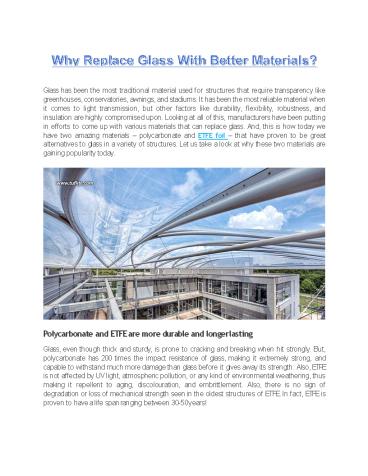Why Replace Glass With Better Materials? - Tuflite Polymers - PowerPoint PPT Presentation
Title:
Why Replace Glass With Better Materials? - Tuflite Polymers
Description:
Glass has been the most traditional transparent material, but it is being replaced by polycarbonate and ETFE because of the amazing qualities of better insulation, easy installation, durability, light diffusion, and more. – PowerPoint PPT presentation
Number of Views:18
Title: Why Replace Glass With Better Materials? - Tuflite Polymers
1
Glass has been the most traditional material used
for structures that require transparency like
greenhouses, conservatories, awnings, and
stadiums. It has been the most reliable material
when it comes to light transmission, but other
factors like durability, flexibility, robustness,
and insulation are highly compromised upon.
Looking at all of this, manufacturers have been
putting in efforts to come up with various
materials that can replace glass. And, this is
how today we have two amazing materials
polycarbonate and ETFE foil that have proven to
be great alternatives to glass in a variety of
structures. Let us take a look at why these two
materials are gaining popularity today.
Polycarbonate and ETFE are more durable and
longer lasting Glass, even though thick and
sturdy, is prone to cracking and breaking when
hit strongly. But, polycarbonate has 200 times
the impact resistance of glass, making it
extremely strong, and capable to withstand much
more damage than glass before it gives away its
strength. Also, ETFE is not affected by UV
light, atmospheric pollution, or any kind of
environmental weathering, thus making it
repellent to aging, discolouration, and
embrittlement. Also, there is no sign of
degradation or loss of mechanical strength seen
in the oldest structures of ETFE. In fact, ETFE
is proven to have a life span ranging between
30-50 years!
2
Polycarbonate and ETFE are shatter-resistant It
is a known fact that glass can be easily
shattered from stone, hail, footballs, and other
impacts. This produces very harmful shards that
are dangerous and difficult to clean up.
Polycarbonate, on the other hand, is virtually
unbreakable with 200 times the impact resistance
of glass. And, even in the worst situations
where it can break, it doesnt produce harmful
shards. The shards produced pose no threat to
humans, and can also be easily cleaned up. ETFE
also is a highly resistant and elastic material,
which makes it the safest building component that
can withstand even the extreme loads of
earthquakes and blasts! Polycarbonate and ETFE
provide better insulation Structures with
transparency require insulation along with light
transmission. While glass can bring in maximum
light, it cannot provide the amount of insulation
required. On the other hand, polycarbonate and
ETFE provide good amount of insulation to the
structure. Lesser heat is lost through
polycarbonate as compared to glass, meaning that
the indoors are warmer and more cost effective
to run. ETFE also has an insulation level similar
to glazing products, and the research to
dramatically improve on these values is still
on. Polycarbonate and ETFE are easier to
install Glass is heavy and is prone to breaking
and cracking, which makes it very difficult to
handle and heavy to transport thus increasing
the labour and costs required. But, polycarbonate
is so light in weight, flexible, and impact
resistant that it can be easily handled,
transported, carried, and installed without the
need of additional labour and machinery. It is
very quick and easy to install polycarbonate.
ETFE also requires minimal energy for
transportation and installation, making it
highly eco-friendly and cost-effective
too. Polycarbonate and ETFE provide better light
diffusion and protection Glass brings in all of
the sunlight it receives, without being able to
keep away any kind of harmful light.
Polycarbonate, in contrast, brings in maximum
sunlight, but only the required type. This means
that it brings in the sunlight required for the
plants and other living beings indoors, but
keeps away the harmful UV rays. Moreover, it
spreads light evenly throughout the structure,
thus reducing damage or sunburn. Similarly, ETFE
also diffuses and reduces direct sunlight. It
keeps away the infrared radiations, and is a
cost-effective way to keep a space lighted up yet
cooled with reduced glare. With the above
points clearly proving how polycarbonate and ETFE
are better alternatives to glass, there is no
doubt in the fact that your next transparent
project should be built by any of these two
contemporary materials. And, whatever material
you decide to use, you must get in touch with
Tuflite Polymers, the leaders in manufacturing
the best quality polycarbonates, and supplying
highly branded ETFE foil and cushions.
3
(No Transcript)































